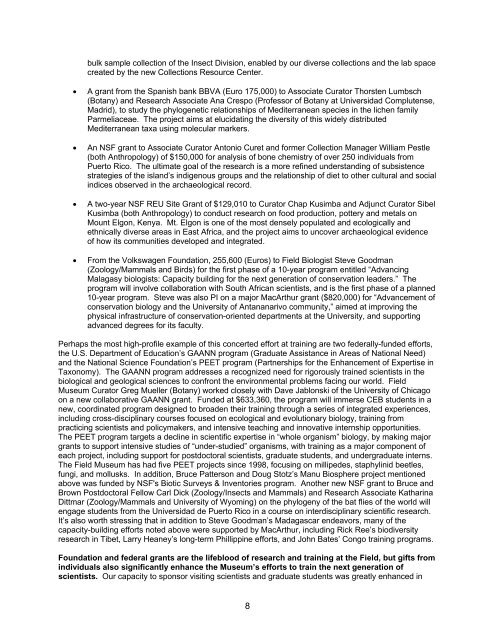2006-2007 - The Field Museum
2006-2007 - The Field Museum
2006-2007 - The Field Museum
Create successful ePaper yourself
Turn your PDF publications into a flip-book with our unique Google optimized e-Paper software.
ulk sample collection of the Insect Division, enabled by our diverse collections and the lab space<br />
created by the new Collections Resource Center.<br />
• A grant from the Spanish bank BBVA (Euro 175,000) to Associate Curator Thorsten Lumbsch<br />
(Botany) and Research Associate Ana Crespo (Professor of Botany at Universidad Complutense,<br />
Madrid), to study the phylogenetic relationships of Mediterranean species in the lichen family<br />
Parmeliaceae. <strong>The</strong> project aims at elucidating the diversity of this widely distributed<br />
Mediterranean taxa using molecular markers.<br />
• An NSF grant to Associate Curator Antonio Curet and former Collection Manager William Pestle<br />
(both Anthropology) of $150,000 for analysis of bone chemistry of over 250 individuals from<br />
Puerto Rico. <strong>The</strong> ultimate goal of the research is a more refined understanding of subsistence<br />
strategies of the island’s indigenous groups and the relationship of diet to other cultural and social<br />
indices observed in the archaeological record.<br />
• A two-year NSF REU Site Grant of $129,010 to Curator Chap Kusimba and Adjunct Curator Sibel<br />
Kusimba (both Anthropology) to conduct research on food production, pottery and metals on<br />
Mount Elgon, Kenya. Mt. Elgon is one of the most densely populated and ecologically and<br />
ethnically diverse areas in East Africa, and the project aims to uncover archaeological evidence<br />
of how its communities developed and integrated.<br />
• From the Volkswagen Foundation, 255,600 (Euros) to <strong>Field</strong> Biologist Steve Goodman<br />
(Zoology/Mammals and Birds) for the first phase of a 10-year program entitled “Advancing<br />
Malagasy biologists: Capacity building for the next generation of conservation leaders.” <strong>The</strong><br />
program will involve collaboration with South African scientists, and is the first phase of a planned<br />
10-year program. Steve was also PI on a major MacArthur grant ($820,000) for “Advancement of<br />
conservation biology and the University of Antananarivo community,” aimed at improving the<br />
physical infrastructure of conservation-oriented departments at the University, and supporting<br />
advanced degrees for its faculty.<br />
Perhaps the most high-profile example of this concerted effort at training are two federally-funded efforts,<br />
the U.S. Department of Education’s GAANN program (Graduate Assistance in Areas of National Need)<br />
and the National Science Foundation’s PEET program (Partnerships for the Enhancement of Expertise in<br />
Taxonomy). <strong>The</strong> GAANN program addresses a recognized need for rigorously trained scientists in the<br />
biological and geological sciences to confront the environmental problems facing our world. <strong>Field</strong><br />
<strong>Museum</strong> Curator Greg Mueller (Botany) worked closely with Dave Jablonski of the University of Chicago<br />
on a new collaborative GAANN grant. Funded at $633,360, the program will immerse CEB students in a<br />
new, coordinated program designed to broaden their training through a series of integrated experiences,<br />
including cross-disciplinary courses focused on ecological and evolutionary biology, training from<br />
practicing scientists and policymakers, and intensive teaching and innovative internship opportunities.<br />
<strong>The</strong> PEET program targets a decline in scientific expertise in “whole organism” biology, by making major<br />
grants to support intensive studies of “under-studied” organisms, with training as a major component of<br />
each project, including support for postdoctoral scientists, graduate students, and undergraduate interns.<br />
<strong>The</strong> <strong>Field</strong> <strong>Museum</strong> has had five PEET projects since 1998, focusing on millipedes, staphylinid beetles,<br />
fungi, and mollusks. In addition, Bruce Patterson and Doug Stotz’s Manu Biosphere project mentioned<br />
above was funded by NSF's Biotic Surveys & Inventories program. Another new NSF grant to Bruce and<br />
Brown Postdoctoral Fellow Carl Dick (Zoology/Insects and Mammals) and Research Associate Katharina<br />
Dittmar (Zoology/Mammals and University of Wyoming) on the phylogeny of the bat flies of the world will<br />
engage students from the Universidad de Puerto Rico in a course on interdisciplinary scientific research.<br />
It’s also worth stressing that in addition to Steve Goodman’s Madagascar endeavors, many of the<br />
capacity-building efforts noted above were supported by MacArthur, including Rick Ree’s biodiversity<br />
research in Tibet, Larry Heaney’s long-term Phillippine efforts, and John Bates’ Congo training programs.<br />
Foundation and federal grants are the lifeblood of research and training at the <strong>Field</strong>, but gifts from<br />
individuals also significantly enhance the <strong>Museum</strong>’s efforts to train the next generation of<br />
scientists. Our capacity to sponsor visiting scientists and graduate students was greatly enhanced in<br />
8

















